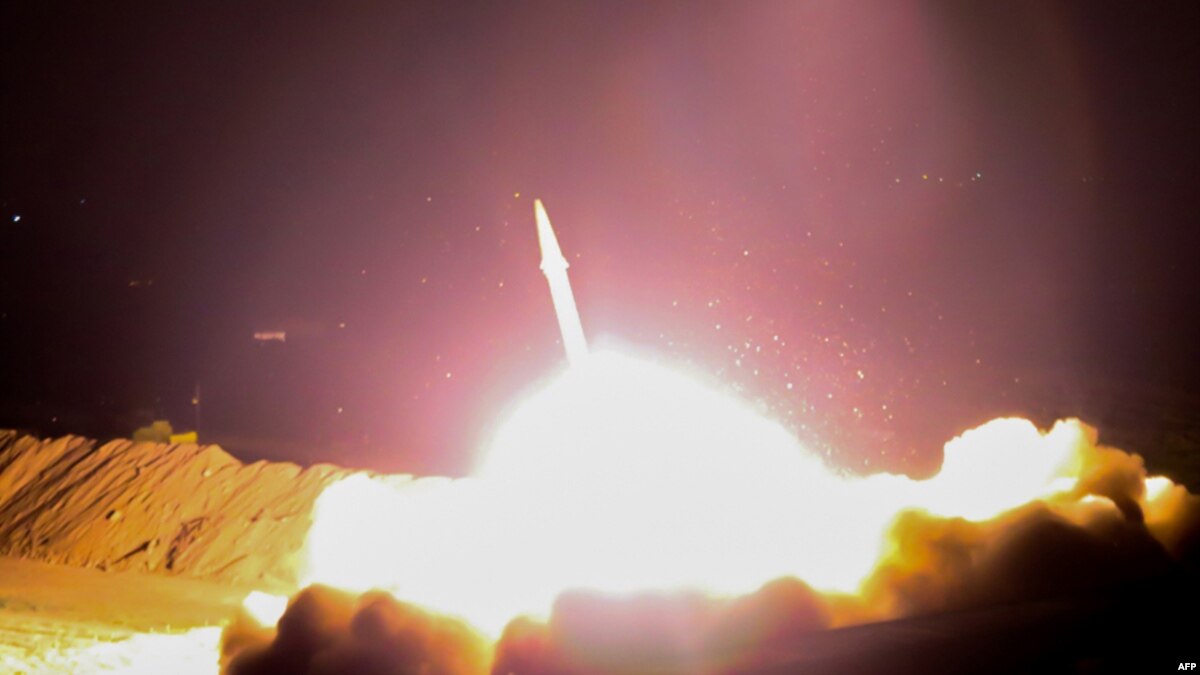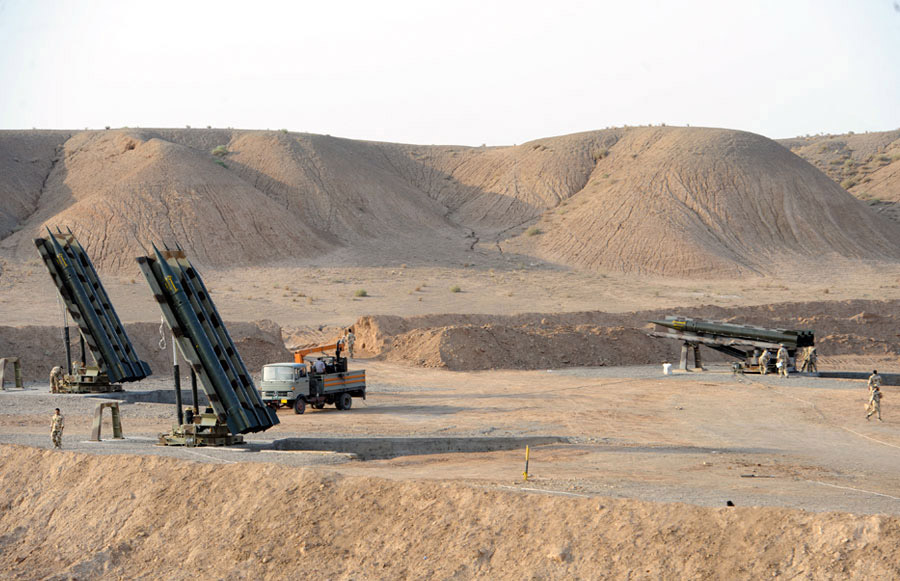For decades, Iran's military has been geared towards countering 2 enemies - the US, and Israel. Against Israel, a large ballistic missile arsenal, coupled with a powerful Hezbollah deters Israel from aggression. Against the US, an asymmetric military designed to inflict politically unacceptable losses, while slowing down any invasion or even occupation.
This approach has been limited in some aspects, but recent changes in threats have highlighted these limitations. The most obvious new threat is, of course, a belligerent and rapidly militarising Saudi Arabia.
The problem of Iran's old air force is quite a well discussed one, so I won't focus on it too much in this post. No, I think the proliferation of sophisticated ABM systems in Saudi Arabia will harm Iran's primary means of deterrent, its missiles - unless addressed.
I don't think the problem is difficult to fix. While Saudi's ABM force is becoming more sophisticated and numerous, Iranian systems to combat them on both sophistication and number are present and developing.
Iran has to enhance high capability assets like the Zolfaqar TBM and Emad MRBM by increasing their accuracy to the point that they can be used as anti-ABM assets. While the Zolfaqar has displayed impressive accuracy in tests, it appears to have had a less precise CEP of about 50 metres when used against ISIS targets in Syria. The Emad's accuracy is unknown, but it is unlikely to be as accurate as the Zolfaqar purely because of the longer range. CEP figures are usually dependent on range.
High capability missiles can have the ability to get through Saudi ABM by using their reduced cross section (as they have MRVs) and manoeuvring capability, which can make interceptors waste energy required for an intercept. If Zolfaqar turns out to be an Iskander-like missile, PAC-3 will be in trouble. I say PAC-3 because THAAD is primarily an exo-atmospheric interceptor, and likely can't be used against a quasi-ballistic missile like Zolfaqar.
Iran has already indicated that it has fit MRBMs and SRBMs with cluster warheads, which would for sure make tracking and interception difficult.
However I think this approach has a flaw. It is politically unusable. While certainly useful against pure military targets like the mega air bases Saudi has constructed, it is not suitable for targets embedded in civilian targets, like the airbase in Dhahran (which is conspicuously close to a hospital). Killing civilians with cluster munitions - even if unintended - is not just immoral (an important consideration in Iran's religious leaders), but also an easy way to turn international opinion against you - and on the side of the enemy. As Iran knows from the Sacred Defence, international opinion is a powerful weapon.
For those targets, Iran has to be smart. Saturate the enemy's defences with a vast volley of very cheap missiles... with no destructive payload. A quickly perishable material, like foil, would serve as a useful decoy on enemy radars, but would burn up before it hits civilians, while also increasing the number of targets for Saudi ABM. Stuff each Zelzal rocket with half a dozen decoys, make the "warhead" separate over the Persian Gulf, and fire a couple hundred. That disables Saudi air defence from pure attrition. Those can be accompanied by the accurate but still cheap Fateh-110s, the silver bullet Zolfaqar and Emad, even those Shahab 1/2s. Why not? Make some more room in the warehouses. THAAD and PAC-3 would likely not intercept the missiles before the warhead separation stage, as they are largely aimed at missiles in the terminal stage.
Even the Khorramshahr can come into play here, its MIRV capability bringing numbers, and its MRBM terminal speed making it troublesome for interceptors. If fitted with Emad-like guided warheads, it could be an exceptionally dangerous weapon.
Iran also has to improve the position of cruise missiles in its military doctrine. There is a very good reason why they are a mainstay of both Western and Eastern military powers, and that is their unrivalled precision, their ability to avoid detection, and their relative affordability. Something with the capability of the Ya Ali LACM - though I must confess, the diminutive size of the Ya Ali makes me doubt the claimed 700 km range.
No explanation necessary.
As I understand, Saudi Arabia, for now, only has the PAC-2 SAM system. In 2015, they signed a deal for the PAC-3, and in 2017 they are close to purchasing THAAD. But none of these advanced interceptors have yet been deployed.
The proposed THAAD deal is for about 360 missiles to be bought with 44 TELs. That's 7 "fire units", including 6 TELs each, with 2 TELs to spare. Saudi would likely put these interceptors around HVTs, like Riyadh, and maybe even a token battery near the 2 Holy Cities (they are, after all, the "Custodians of the Holy Mosques"...). This reduces the number of interceptors devoted to strategic targets like large airbases, and the oil production facilities in Eastern KSA. Furthermore, as with the PAC-3, it is likely there would be 2 THAAD interceptors launched for every ballistic missiles, dwindling ABM capability further.
Overall, I think that while THAAD and PAC-3 are a challenge, they are not by any means insurmountable. They require smart development and tactics, with an enhanced concept of the swarm. But none of these things are difficult or costly for Iran.
This approach has been limited in some aspects, but recent changes in threats have highlighted these limitations. The most obvious new threat is, of course, a belligerent and rapidly militarising Saudi Arabia.
_interceptors_is_launched_during_a_successful_intercept_test_-_US_Army.jpg/1200px-The_first_of_two_Terminal_High_Altitude_Area_Defense_(THAAD)_interceptors_is_launched_during_a_successful_intercept_test_-_US_Army.jpg) |
| THAAD |
The problem of Iran's old air force is quite a well discussed one, so I won't focus on it too much in this post. No, I think the proliferation of sophisticated ABM systems in Saudi Arabia will harm Iran's primary means of deterrent, its missiles - unless addressed.
I don't think the problem is difficult to fix. While Saudi's ABM force is becoming more sophisticated and numerous, Iranian systems to combat them on both sophistication and number are present and developing.
Sophistication
 |
| Zolfaqar |
Iran has to enhance high capability assets like the Zolfaqar TBM and Emad MRBM by increasing their accuracy to the point that they can be used as anti-ABM assets. While the Zolfaqar has displayed impressive accuracy in tests, it appears to have had a less precise CEP of about 50 metres when used against ISIS targets in Syria. The Emad's accuracy is unknown, but it is unlikely to be as accurate as the Zolfaqar purely because of the longer range. CEP figures are usually dependent on range.
High capability missiles can have the ability to get through Saudi ABM by using their reduced cross section (as they have MRVs) and manoeuvring capability, which can make interceptors waste energy required for an intercept. If Zolfaqar turns out to be an Iskander-like missile, PAC-3 will be in trouble. I say PAC-3 because THAAD is primarily an exo-atmospheric interceptor, and likely can't be used against a quasi-ballistic missile like Zolfaqar.
Numbers
Iran has already indicated that it has fit MRBMs and SRBMs with cluster warheads, which would for sure make tracking and interception difficult.
However I think this approach has a flaw. It is politically unusable. While certainly useful against pure military targets like the mega air bases Saudi has constructed, it is not suitable for targets embedded in civilian targets, like the airbase in Dhahran (which is conspicuously close to a hospital). Killing civilians with cluster munitions - even if unintended - is not just immoral (an important consideration in Iran's religious leaders), but also an easy way to turn international opinion against you - and on the side of the enemy. As Iran knows from the Sacred Defence, international opinion is a powerful weapon.
For those targets, Iran has to be smart. Saturate the enemy's defences with a vast volley of very cheap missiles... with no destructive payload. A quickly perishable material, like foil, would serve as a useful decoy on enemy radars, but would burn up before it hits civilians, while also increasing the number of targets for Saudi ABM. Stuff each Zelzal rocket with half a dozen decoys, make the "warhead" separate over the Persian Gulf, and fire a couple hundred. That disables Saudi air defence from pure attrition. Those can be accompanied by the accurate but still cheap Fateh-110s, the silver bullet Zolfaqar and Emad, even those Shahab 1/2s. Why not? Make some more room in the warehouses. THAAD and PAC-3 would likely not intercept the missiles before the warhead separation stage, as they are largely aimed at missiles in the terminal stage.
 |
| Zelzal-3 rockets |
Even the Khorramshahr can come into play here, its MIRV capability bringing numbers, and its MRBM terminal speed making it troublesome for interceptors. If fitted with Emad-like guided warheads, it could be an exceptionally dangerous weapon.
Cruise Missiles
Iran also has to improve the position of cruise missiles in its military doctrine. There is a very good reason why they are a mainstay of both Western and Eastern military powers, and that is their unrivalled precision, their ability to avoid detection, and their relative affordability. Something with the capability of the Ya Ali LACM - though I must confess, the diminutive size of the Ya Ali makes me doubt the claimed 700 km range.
An Advanced Air Force
No explanation necessary.
Saudi ABM Isn't As Powerful As Many Fear
As I understand, Saudi Arabia, for now, only has the PAC-2 SAM system. In 2015, they signed a deal for the PAC-3, and in 2017 they are close to purchasing THAAD. But none of these advanced interceptors have yet been deployed.
The proposed THAAD deal is for about 360 missiles to be bought with 44 TELs. That's 7 "fire units", including 6 TELs each, with 2 TELs to spare. Saudi would likely put these interceptors around HVTs, like Riyadh, and maybe even a token battery near the 2 Holy Cities (they are, after all, the "Custodians of the Holy Mosques"...). This reduces the number of interceptors devoted to strategic targets like large airbases, and the oil production facilities in Eastern KSA. Furthermore, as with the PAC-3, it is likely there would be 2 THAAD interceptors launched for every ballistic missiles, dwindling ABM capability further.
Overall, I think that while THAAD and PAC-3 are a challenge, they are not by any means insurmountable. They require smart development and tactics, with an enhanced concept of the swarm. But none of these things are difficult or costly for Iran.
Comments
Post a Comment
A few quick rules:
-No trolling, spam etc.
-Keep it civil, I don't want to see ad hominems.
-Anyone from any country or territory can comment on this blog, just bear in mind I won't be very patient with bullshit. This is a blog on Geopolitics and Military issues of Iran, where you can discuss this as you like. Don't come here with an agenda or a bone to pick.